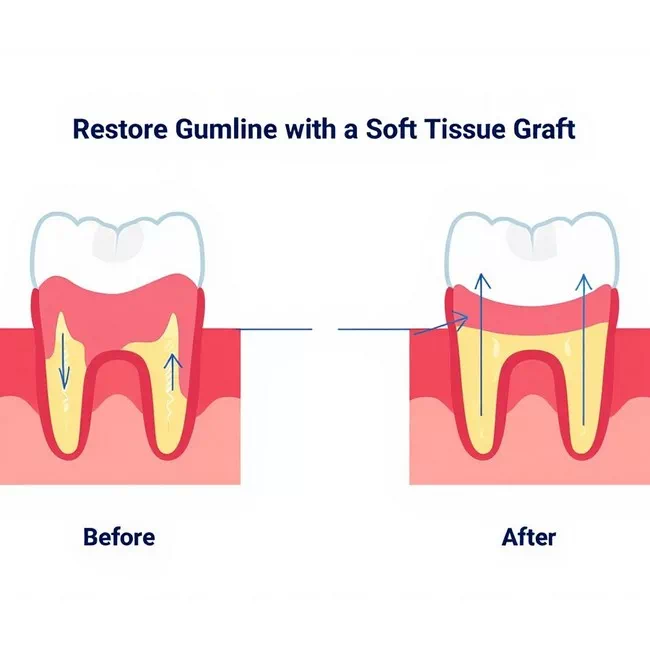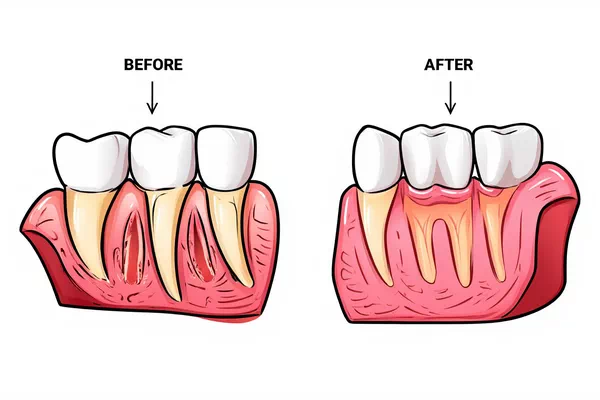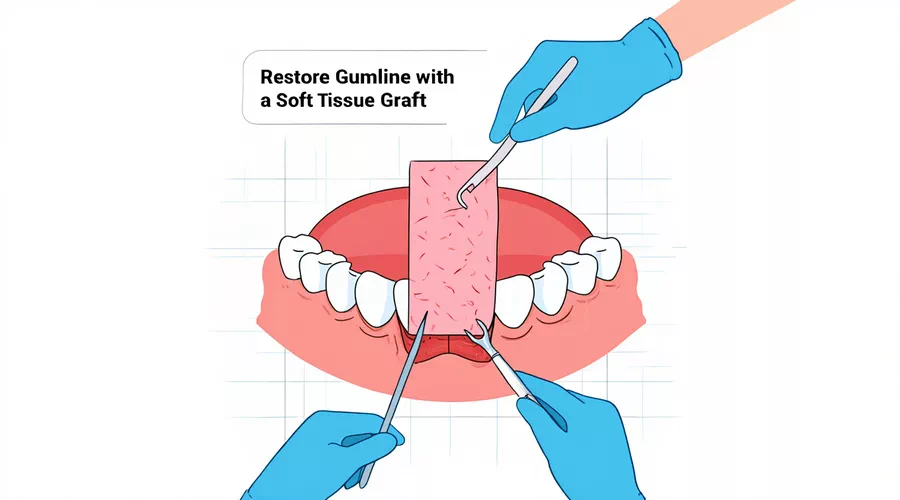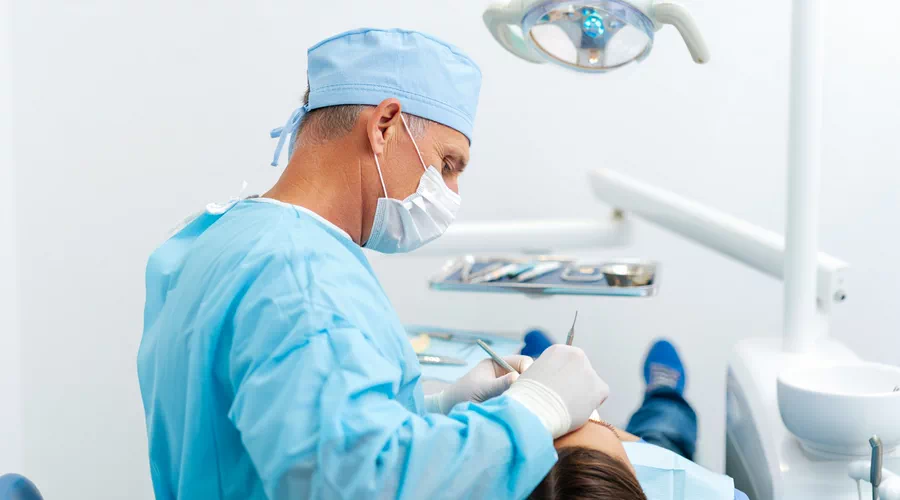Gum Graft in Lorton VA
Gum grafting procedures help prevent periodontal disease and tooth decay. Dr. Vladimir Soyfer at Lorton Dentist use the latest surgical techniques to perform gum grafting. Our Lorton, VA practice prides itself on performing soft tissue grafting with precision, minimal discomfort, and aesthetically pleasing results.

What is a gum graft and why is it needed?

A gum graft is a surgical procedure that is used to treat gum recession. Gum recession is a condition where the gums recede from the tooth, exposing the root. This can lead to increased tooth sensitivity, risk of tooth decay, and ultimately tooth loss.
The main goal of a gum graft is to cover the exposed root of the tooth with healthy gum tissue. This protects it from further damage and improves the appearance of the smile.
Types of Gum Grafts

There are several types of gum grafts, each suited to specific situations:
- Connective Tissue Graft:
This is the most common method. An incision is made in the roof of the mouth (the roof of the mouth) and connective tissue is taken from underneath the incision. This tissue is sutured to the gum tissue around the exposed root. The incision in the roof of the mouth is then sutured back together. - Free Gingival Graft:
Similar to a connective tissue graft, but tissue is taken directly from the roof of the mouth instead of from underneath an incision. This method is often used when the gums are thin and need to be thickened. - Pedicle Graft:
Gum tissue that is close to the site of recession is used. The flap of gum tissue is partially cut away, leaving one edge attached. This flap is then moved to cover the exposed root and sutured into place. This method is only possible if there is sufficient healthy gum tissue near the recession site.
How the procedure is performed?

- Consultation and examination:
Before the procedure, your doctor will perform a thorough examination of your mouth and take x-rays to assess the extent of your gum recession and determine the best treatment option. - Anesthesia:
During the procedure, local anesthesia is usually used to numb the area. In some cases, sedation may be used to help relax the patient. - Performing the surgery:
The length of the procedure depends on the extent of your gum recession and the type of graft used, but it usually takes between one and two hours. - Aftercare:
Some discomfort and swelling can be expected after the gum graft. Your doctor will prescribe pain medication. It is important to follow your doctor’s instructions carefully to ensure proper healing. This may include eating soft foods, avoiding strenuous exercise, and using a special mouthwash. - Healing:
The healing process usually takes several weeks. During this time, the grafted tissue gradually fuses with the surrounding gum tissue. It is important to attend follow-up visits to monitor the healing process and ensure the success of the transplant.
Do you need a gum graft?
Book an Appointment Today

The specialists of the Lorton Dentist will conduct a detailed consultation and prescribe the necessary type of gum graft.
During the procedure, local anesthesia is used to numb the area.
You can contact the practice online or call the number provided to schedule an appointment.
Potential risks and complications
Although gum grafting is usually successful, there are some potential risks and complications:
- Bleeding
- Infection (rare)
- Swelling and discomfort
- Failure of the graft to take (more common in smokers or people with poor oral hygiene)
- Temporary numbness of the gums or roof of the mouth (usually resolves within a few weeks or months)
Preventing More Serious Problems
Gum grafting is often a step toward improving overall oral health. By reversing gum recession, patients not only improve the appearance of their smile, but also reduce the risk of developing more serious dental problems in the future. Exposed tooth roots are more susceptible to decay, and loss of gum tissue can weaken the supporting structures of teeth, increasing the risk of tooth loss.
Gum grafting demonstrates a commitment to long-term oral health and can help prevent the need for more extensive and costly dental treatment in the future.
FAQ
What is a gum graft and why is it needed?
A gum graft is a surgical procedure in which gum tissue is transferred from one area of the mouth (usually the roof of the mouth) to another area where the gum has receded or is missing. This procedure is necessary to restore the gum contour, protect the roots of the teeth, and improve the aesthetics of the smile. Gum recession can lead to increased tooth sensitivity, root decay, and eventually tooth loss. A gum graft is an effective way to prevent these problems and maintain healthy teeth for many years.
How long does it take to recover from a gum graft?
Recovery from a gum graft usually takes several weeks to several months. There may be some swelling, discomfort, and tenderness in the first few days after the procedure. It is important to follow your dentist’s instructions, take pain medications as needed, and follow a gentle diet, avoiding hard and spicy foods. It is important to rinse your mouth regularly with an antiseptic solution and avoid trauma to the graft area. It may take several months for the graft to fully heal and take hold, during which time it is important to follow all of your dentist’s instructions and attend regular check-ups.
What are the Alternatives to Gum Grafting?
In some cases, if the gum recession is not too severe, alternative treatments may be considered, such as:
- Deep cleaning (scaling and root planing): This procedure helps remove tartar and plaque from the roots of the teeth, which can help reduce inflammation and stabilize the gums.
- Using toothpastes and rinses for sensitive teeth: These products help reduce tooth sensitivity caused by exposed roots.
- Veneers or crowns: In some cases, veneers or crowns may be used to cover exposed roots and improve aesthetics.
However, if the gum recession is significant and poses a threat to the health of the teeth, gum grafting is the most effective and reliable treatment option.
